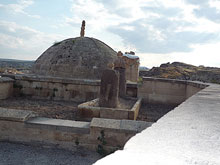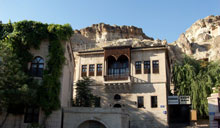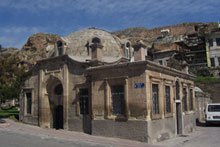- A practical guide to Cappadocia
- French
- English

Here is what Pat Yale wrote about Ürgüp in 2009. Originally from the UK, Pat Yale is a well-known travel writer who has lived in Göreme, Turkey for nearly fifteen years. She is the author of a number of well-known books about Turkey, including A Handbook for Living in Turkey. She has also written for Today’s Zaman and Istanbul Time Out. Read the original article here.
"Cappadocia, with its wonderful landscape and many cave monuments, is, for the most part, a rural area, but what if you want to visit it but don't fancy staying in a village? Well, Ürgüp should fit the bill nicely, since it's right in the heart of the moonscape, and, with a population of around 12,000 inhabitants, manages all the amenities of a small town: shops (not all of them selling tourist souvenirs), restaurants and a wide range of hotels. What's more, although it lacks the more formal attractions of nearby Göreme, it still offers more than enough to fill a couple of days of anyone's holiday comfortably.
There has been settlement on the site of Ürgüp since long before the Romans came, although most of the evidence is, unfortunately, hidden in caves deep inside the town's three hillsides. More evidence survives of the Romans, who left a necropolis right in the heart of town where individual tombs are currently being subsumed into an extension of a hotel. In the Middle Ages, Christian monks must have settled in the area although there's not a lot left to show for them, especially in comparison with what can be seen in Göreme. Still, the crumbling and inaccessible rock-cut church of St. Procopius (after who the town was originally called Prokopi) is visible near the Yunak Evleri hotel.
 But it was really in the 19th and 20th centuries, and especially in the years immediately preceding the Greek-Turkish population exchange of 1924,
that Ürgüp really came into its own. It was in those years that many of the magnificent mansions that can still be seen to the east of the town center
were built.
But it was really in the 19th and 20th centuries, and especially in the years immediately preceding the Greek-Turkish population exchange of 1924,
that Ürgüp really came into its own. It was in those years that many of the magnificent mansions that can still be seen to the east of the town center
were built.
To get your bearings, it makes sense to start your explorations on the summit of Temenni Hill (Wishing Hill), 1,100-meters high, a huge, hole-pierced plug of rock that dominates the town center. To get there, head up the hill leading out of town toward Göreme until you come to the newly restored Inkilip primary school on the right. Take the street in front of it and follow it up as it zigzags its way to the top.
A rockfall in 2006 resulted in much of the summit being concreted over to stabilize the hill; however, there are two interesting small buildings up here that are well worth inspecting. The first is a türbe (tomb) dedicated to the Selçuk Sultan Ruknettin Kiliçarslan IV, who arrived in Ürgüp after surviving an attempt to poison him in Aksaray. Unfortunately, his enemies were hot on his tail and succeeded in killing him here, whereupon his body was taken away to Konya for burial. In 1863, the shrine on Temenni Hill was erected to commemorate his murder.
 Descending from Temenni, you might want to
follow the main road uphill past the Ögretmen Evi, a small local example of a style of building dubbed "First National" architecture, which drew on
elements of Selçuk and Ottoman styles to create something entirely new. Just past it is a small square dominated by a monument not to a famous individual
but to a television series: Some of "Asmali Konak" was filmed in a building tucked up a nearby side street, and it proved such a smash hit that it helped
put Cappadocia on the domestic tourism map.
Descending from Temenni, you might want to
follow the main road uphill past the Ögretmen Evi, a small local example of a style of building dubbed "First National" architecture, which drew on
elements of Selçuk and Ottoman styles to create something entirely new. Just past it is a small square dominated by a monument not to a famous individual
but to a television series: Some of "Asmali Konak" was filmed in a building tucked up a nearby side street, and it proved such a smash hit that it helped
put Cappadocia on the domestic tourism map.
 As you return to the town center you will be able to admire many of the fine mansions of Ürgüp, with their elaborately decorated door and window frames.
Then, just past the Yahya Efendi Medresesi, you will see a once lovely but now crumbling house built over an arch which leads through to the old part
of town where many people still live in cave houses. If, instead, you continue downhill and then turn right you will come to one of Ürgüp's more
unlikely attractions: the Şehir Hamamı (Turkish bath), housed inside what was once a Greek church.
As you return to the town center you will be able to admire many of the fine mansions of Ürgüp, with their elaborately decorated door and window frames.
Then, just past the Yahya Efendi Medresesi, you will see a once lovely but now crumbling house built over an arch which leads through to the old part
of town where many people still live in cave houses. If, instead, you continue downhill and then turn right you will come to one of Ürgüp's more
unlikely attractions: the Şehir Hamamı (Turkish bath), housed inside what was once a Greek church.
 The town centre is marked by a plaza dotted with cafes, restaurants and a modern clock tower. On the far side of it, Atatürk Bulvarı is lined with
carpet and antique shops, and runs past a park inside which you'll find Ürgüp's small and unexceptional museum.
The town centre is marked by a plaza dotted with cafes, restaurants and a modern clock tower. On the far side of it, Atatürk Bulvarı is lined with
carpet and antique shops, and runs past a park inside which you'll find Ürgüp's small and unexceptional museum.
These days, Ürgüp is also famous for its many luxurious cave hotels, the majority of them in the Esbelli Mahallesi behind the Turasan winery. Here you'll find the discreet and lovely Esbelli Evi, whose owner kick started the cave-hotel movement. Here, too, are the Ürgüp Evi, Elkep Evi, Serinn House and Kayadam hotels, while a little way further downhill the lovely Yunak Evleri occupy a cluster of old stone buildings nestling beneath a rock face pitted with ancient pigeon houses...
 And what of the peribacalari
(fairy chimneys), the crazily conical rock formations for which Cappadocia is famous? Well, take the road out of town toward Göreme and almost
immediately you will come to a group of them right beside the road. Given that there are two large and two small chimneys, the locals refer to this
gathering rather charmingly as "the family." "
And what of the peribacalari
(fairy chimneys), the crazily conical rock formations for which Cappadocia is famous? Well, take the road out of town toward Göreme and almost
immediately you will come to a group of them right beside the road. Given that there are two large and two small chimneys, the locals refer to this
gathering rather charmingly as "the family." "
Sundays's Zaman, 4th January 2009, Pat Yale
Top of Turkey © 2019. Designed by AE Teknoloji